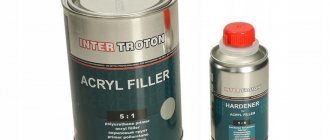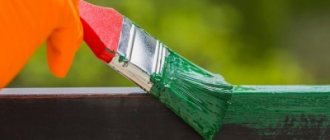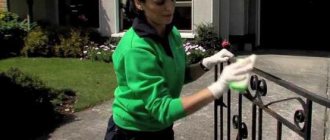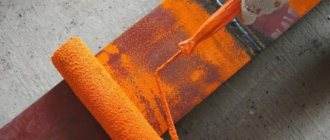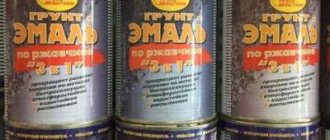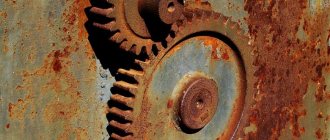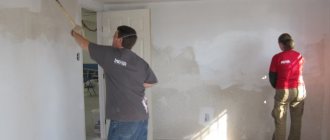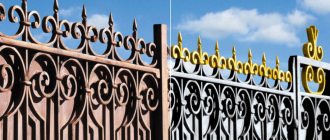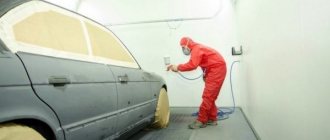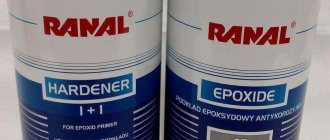When processing a car body to create a uniformly smooth surface, it is almost impossible to do without a primer. Correctly selected acid, epoxy or acrylic primer for a car creates additional protection, eliminates dents and irregularities, and ensures a tight fit of paintwork materials. The most popular due to its ease of use and quick-drying properties is acrylic. However, other types of primers have their own advantages and applications.
What is the soil for?
Automotive primer (from German der Grund - “soil”, “base”) is a specialized viscous mixture that tends to harden and acts as an intermediate layer between metal and paint.
It performs a preparatory function and solves the following tasks:
- ensuring the anti-corrosion resistance of the body and parts, protecting them from moisture and rust;
- improving the adhesive properties of the surface when applying paint and varnish;
- elimination of dents, cracks and chips during cosmetic repairs of the car;
- increasing the service life of car enamel, its strength and preservation of appearance;
- creating a flat surface for painting a car, which ensures good quality of work performed.
The chemical industry produces and markets a large number of base mixtures, differing in composition, number of components and purposes of use. They are sold in liquid and paste form, packaged in cans or aerosol cans.
Based on their protective properties, all types of primers can be divided into 4 groups:
- Passivating. Used for processing the bottom, sills and wings. The surface treated with this composition is impervious to water and air.
- Protective. Slow down the spread of the lesion in case of damage to the paintwork.
- Phosphating. As a result of their use, the surface layer of the metal is corroded and a protective film is formed due to the formation of poorly soluble substances.
- Modifiers. They are applied directly to rust, preventing the spread and increasing resistance to its reappearance. For the protective reaction to occur effectively, a temperature of at least +15°C is required.
Differences in paints
Before you understand whether it is possible to paint products coated with acrylic with alkyd paint, you need to understand the compatibility of these enamels.
- Acrylic paint bases last longer on the surface. Alkyd enamels are not so durable. And if the product or surface is cleaned and primed before painting, the coating will remain for more than 20 years. Surfaces coated with alkyds become unusable a year after the first painting.
- Acrylic is indifferent to the effects of ultraviolet rays. Under direct sunlight, the enamel does not peel, does not turn yellow, and does not lose transparency. The Alcides cannot boast of this.
- But alkyd paints dry faster. Therefore, they are indispensable for quick coloring. Unlike competitors, which only need two days to dry completely, acrylics dry for a month.
- Acrylics take a long time to dry, but during this process a film is formed that is more resistant to mechanical damage. Other coatings do not differ in such properties.
- Alkyd substances have a wide variety of shades, which is not typical for acrylic paints. If choosing non-standard colors is important, it is better to choose acrylic enamels.
Varieties by number of components
An important performance characteristic of a primer is its drying speed.
This indicator depends on the use of additional components when composing the mixture: filler, hardener, various chemical additives and elements.
Based on this criterion, soils are divided into 3 groups:
- One-component. They go on sale ready-made. Before starting work, just stir them until they have a homogeneous consistency. They are used extremely rarely in auto repair shops and service stations due to the long drying period (several days).
- Two-component. Before use, they require adding a hardener, which saves a lot of time when working. Dries in 24 hours.
- Ethanol. Used to eliminate defects in minor damage. They use the ability of alcohols to quickly evaporate, which allows the composition applied to the surface to dry within 1 hour. In both soft and hard consistency, they are convenient for application and subsequent sanding.
Alkyd paint and its properties
To create this type of enamel, a thick resin is used, and various solvents from refined petroleum products are added to the viscosity. The role of filler is played by finely ground sand, as well as granite chips crushed to dust. Unlike acrylic enamels, alkyd coating can be of several types: matte and glossy. When covering the surface with alkyd paint, you do not need to worry about the influence of external factors: the enamel will protect the product from snow, rain, and minor mechanical damage. This substance dries well, masks imperfections well, and can be used both outdoors and in a house or apartment. The advantages of such substances:
- Dries quickly.
- They are not subject to destruction after frequent exposure to the street, after exposure to rain, snow or hail.
- They do not streak, they lie flat on a previously cleaned, primed product.
- They are distinguished by a variety of shades for the palette.
Pay attention to: How and with what to paint plaster products
Disadvantages of alkyd paint:
- Exposure to sunlight and high temperatures.
- They have a strong odor, and therefore it is necessary to apply enamel to a product or surface in a well-ventilated area or in the fresh air.
Alkyd matte paint
Classification by composition
The composition of the mixture determines the place and technology of its application. The presence of aggressive acids in the primer forms a protective film due to chemical interaction with the metal. The presence of resins provides physical impermeability to moisture.
The addition of zinc, aluminum, and chromium powders creates the effect of galvanized body and parts, and inert particles guarantee water repellency.
In addition, application is carried out on different materials and each of them requires its own mixture.
All primers for cars are divided into 2 main types:
- Primers (from the English prime - “main”, “first”), intended for primary processing. Their main tasks are to create anti-corrosion protection for the body and ensure better adhesion of the car enamel to the surface.
- Fillers (from the English fill - “fill”). They are used during secondary finishing for leveling, forming a substrate for paint and protecting against weak mechanical influences.
Acidic (for rust and problem areas)
The action of these compositions is based on the principle of passivation or phosphating, since the most commonly used component in them is phosphoric acid. It allows you to implement the mechanism of adhesion to the surface:
- penetration of the primer into the metal structure to a depth of 0.05 microns due to corrosion of the surface;
- entering into a chemical reaction with the formation of sparingly soluble phosphates;
- the formation of a durable anti-corrosion film from them during hardening.
It is recommended to apply the primer in 2 layers, as a result of which its maximum possible adhesion to the surface being treated is achieved. This provides not only protection against rust, but also high quality and durability of the paintwork. The adhesion process of acid mixtures is equally effective with any alloys from which a car can be made (galvanized and galvanized steel, non-ferrous metal, aluminum alloys, etc.). The aggressiveness of the impact is used to process hard-to-reach places and parts.
It should be taken into account that it is no longer acceptable to putty on such a surface. Application of the material causes a reaction that destroys the primer layer.
Epoxy for metal
Another equally popular group of primers are epoxy resin-based primers. When using them, material properties such as viscosity and density are used. Resins create an air- and moisture-proof thick layer up to 0.15 microns, which provides long-term (up to 7 years) protection for treated parts. The use of such mixtures prevents the appearance of bubbles, and the increased stickiness allows them to be applied over putty, metal and remnants of old paintwork.
Epoxy primers do not require sanding. You can putty and paint over them without waiting for complete drying. And although it is recommended to apply a layer of acrylic on top of them, practice shows that this is an unnecessary precaution. Being chemically neutral, epoxies can act as an insulator between problematic or incompatible surfaces and materials.
Acrylic primer
Acrylics belong to the class of fillers (secondary primers) and are intended to eliminate minor risks and surface defects remaining after sanding, as well as to create a substrate for final painting. To ensure color stability, they use colored pigments: red, black, white and gray. For minor abrasions and scratches, this makes the damage invisible, and also increases the covering power of the enamel and saves its consumption.
Many acrylic mixtures allow for a “wet on wet” painting method. This eliminates grinding and saves processing time and labor costs. But the mixture should be applied in 2-3 layers to create a thickness of 100-150 microns. Acrylics are resistant to temperature fluctuations, humid conditions, and mechanical vibrations. You can work with them on both metal and plastic.
They are two-component; depending on the TDS, they are mixed with a hardener and solvent in various ratios - 5:1, 4:1 or 3:1. This determines the viscosity and adhesive properties of the resulting material. But single-component aerosol levelers, produced in cans, have gained particular popularity. They are convenient for cosmetic repairs, do not take time to dilute the mixture and dry quickly.
Composition for plastic parts
To prime plastic parts (bumpers, fenders, interior decorative elements), special adhesive compounds are used, which are applied in one layer and create strong adhesion to the material. This is achieved by liquefying the surface and then hardening it. Most often, one-component acrylic and alkyd mixtures are used for these purposes. They are transparent, and to distinguish the primed surface from the untreated one, a little silver paint is added to them.
However, in 80% of cases, plastic parts go on sale already prepared and do not require reprocessing.
Paving stones and paving slabs
An auxiliary building material such as a primer is recommended to be used to prepare wooden, metal, concrete and brick surfaces for finishing work. Today, there are many primers on the building materials market that differ in their basic chemical composition, purposes, and methods of application. Most often, ready-made alkyd or acrylic solutions are used in repair work.
Acrylic primers
Using a primer based on a styrene-acrylic dispersion, you can prepare concrete, brick, and wood for finishing treatment. According to their purpose and function, primer solutions can be universal, specialized, adhesive, strengthening; there are separate compositions for facade and interior work. There are also primers (see here) with a deep impregnation function. Adhesive, in addition to polymer, acrylic and additives, contain tiny quartz particles, which make the treated surface rougher. This prepares the surface well for “setting” with glue, cement mortar, and plaster. This adhesive composition is most often used before laying tiles on a fairly smooth surface.
The main purpose of using a deep penetration primer is to penetrate the layer to the maximum depth to enhance adhesion. After applying such a primer, the material’s ability to absorb moisture is reduced, which reduces paint consumption. This primer can be used for additional and reliable bonding of fresh plaster to the base before painting or wallpapering. Strengthening primer is used for the treatment and restoration of loose, porous bases. It gets into microcracks and makes the surface monolithic.
Alkyd primers
This primer is applied only to wooden and metal surfaces before painting, applying a layer of putty or wallpaper glue. After covering with this primer, a thin film appears on top, which enhances the adhesion properties of the paint to wood or metal. In addition, the wooden surface becomes moisture resistant, and therefore more durable. It is worth saying that after treatment with this primer, it is recommended to use only alkyd paints.
This primer is not suitable for concrete surfaces or brick walls, as it does not penetrate deep into these materials, but it has a good anti-corrosion effect. Alkyd primers for metal surfaces contain zinc phosphate, which protects the material from rust.
(1 rating, average 5 out of 5)
Advantages and disadvantages of soils
Despite the fact that the primer is not visible at the end of the work, both the quality and durability of the completed painting depend on it. After high-quality coating application, the following are guaranteed:
- protection against rust and corrosion;
- smooth substrate for painting;
- presentable appearance of the car;
- there are no reasons for cracking, bubbles and subsidence in the enamel.
What primer should be chosen to achieve this is up to the car owner to decide for himself, but one piece of advice from the experts is worth listening to. The point is that you cannot skimp on this mixture.
You should choose proven brands: only in this case can you count on getting a high-quality result.
Cheap primers are dangerous because during drying they shrink unevenly, which leads to disruption of the evenness of the coating, loss of appearance, the formation of cracks and the formation of rust.
Auto primer in a can (aerosol)
If a small amount of primer is required for repairs, then it is more advisable to use aerosol primer. It is great for certain areas of the body that have lost their attractive appearance and have worn down to bare metal. The main advantage of such primers is their economical use, because when using a spray gun, most of the paintwork would remain on its walls.
Like acrylic primers, they provide good adhesion to the paintwork and base, improving their characteristics, and protect the surface from corrosion.
Popular manufacturers of primers for painting
The leading positions in surveys and ratings belong to foreign companies, among which the products of widely advertised brands stand out:
- Hi-Gear;
- Liqui Moly;
- Dynacoat;
- Mobihel;
- NOVOL;
- Duxone;
- ABRO.
Domestic manufacturers, distinguished by high-quality products and gaining fame in the country, are represented by the following companies:
- “Russian Paints” (Yaroslavl);
- Moscow LLC "Empresa-M";
- LLC "KhimTorgProekt" from St. Petersburg.
Which is better – acrylic or alkyd enamel?
When choosing between alkyd or acrylic enamel, which is better, it is difficult to understand. Much depends on what base the paint is applied to and under what conditions the coating is used. Additionally, it is necessary to analyze the characteristics of both mixtures.
On the left is alkyd paint from Symphony, 2 is acrylic enamel from Tex.
- Details about acrylic enamel and its use
- About the features of alkyd enamel
- Which paint is better - alkyd or acrylic?
- Enamels compatibility
The best primary acid soils
Among single-component acid primers that do not require the addition of catalysts, experts highlight Mobihel Primer 1K. It is convenient and easy to apply. Used for priming on steel, galvanized and aluminum. Has a short drying time. Estimated price 950-1 thousand rubles. for 1 l.
In two-component ones, a hardener is added, often included with the main mixture. Widespread:
- NOVOL Protect 340 Wash Primer - used on ferrous and non-ferrous metals. Hardens quickly. Does not require sanding, but acrylic processing is required. Sold together with hardener. Average prices: 500 rub. per set 0.2+0.2 l; 1.9-2 thousand rubles. — 1+1 l.
- Radex CR 1+1 Activator - applied to any metal surface. Recommended for repairing new cars. The price for a set of 2 cans ranges from 2 thousand rubles. up to 2.5 thousand rubles.
Types of water-based primers
First of all, water-based primers are divided by type of composition.
The most common:
- Acrylic water-dispersion coatings;
- Alkyd water-based;
- Alkyd-acrylic;
- Latex;
- Silicone.
Now let's take a closer look at the features of these coatings.
Deep penetration acrylic primer
Acrylic
Acrylic water-dispersion primer is by far the most common. With its help you can get reliable adhesion to almost any type of surface.
It should be said right away that acrylic primers come in two types of action:
- Deep penetration - as you might guess, they penetrate deeply into the base and strengthen it, gluing even dust.
- Adhesive – improves adhesion of low-porosity surfaces.
Water-dispersive deep-penetrating universal primer according to GOST R 52020-2003 is a dispersion of acrylic polymers with the addition of various special components.
This composition can be applied to the following types of surfaces:
- Concrete;
- Wood;
- Plaster and putty;
- Drywall;
- Fiberglass wallpaper, etc.
It must be said that there is an opinion that water-based primers cannot be used on metal surfaces, as they cause corrosion. However, this is not true. There are special water-based adhesives that are designed to coat metal surfaces.
Recommended sealer primers
A group of sealers (insulators) is designed to eliminate the possibility of contact of conflicting materials. The most effective for this purpose are viscous epoxies, which create a dense protective layer.
Acrylic primers designed for wet-on-wet work also have insulating properties. They are used either as a direct substrate for painting, or with the subsequent addition of filler.
Compatibility
Knowing the differences between alkyd paint and acrylic paint, you should also learn about the compatibility of these two paints. Many people are interested in the question of whether it is possible to apply a layer of alkyd paint on top of acrylic paint.
It must be said that the compatibility of the two products is not very good. This is due to the composition of the materials. If you combine them, there is a risk of surface swelling. If you apply acrylic to alkyd, the result will not be good - the coating will begin to delaminate. But if there is a serious need to combine these different products, then you need to clean the surfaces as much as possible, then carefully sand them and apply primer. This will help improve adhesion and reduce the risk of peeling, but the service life is reduced by about half.
Primers for secondary application
The functions of fillers are varied, since they are the final stage of work before applying enamel and are designed to eliminate all existing surface defects, level planes and joints, isolate problematic materials and ensure a tight adherence of paint. When working with them, it is necessary to eliminate the slightest risks and carefully polish the surfaces (to a depth of 30 microns). Leveling should remove all defects and pores remaining after putty, and level out the transition points from one plane to another.
Colored, for painting
The use of colored primers became popular in the 80s and 90s. last century. Few people imagined that such a simple know-how as adding coloring pigments to the mixture would become widespread and provide such great savings in material consumption. This especially applies to interior parts and the space under the hood. The Japanese, Koreans, and more recently AvtoVAZ have refused to paint them, considering treatment with a colored (tinted) primer coating sufficient.
High build primers
The standard thickness of primers applied in 2-3 layers is 100-140 microns. However, a number of manufacturers (Liqui Moly, AUTOP) produce compositions that, when applied, form a layer of 260-300 microns. They are convenient to use on large surfaces during major repairs. The use of such primers ensures high-quality leveling and allows you to eliminate the putty step from the processing process. These primers are most often produced in the form of an aerosol and demonstrate high-quality adhesion when painted wet.
Soil-aerosol companies
The convenience of using the compounds in aerosol cans, their ability to dry quickly and the ability to save effort and time (there is no need to dilute the mixture or work with a spray gun) were highly appreciated by repairmen. The Russian market today is dominated by such manufacturers as Kudo, Sadolin, Loctite, Jeta Pro, Brulex, NOVOL and many others. The price is also attractive - from 250 rubles. up to 800 rub. per canister with a capacity of 0.5 liters.
Acrylic paint and its features
The main property of acrylic is the presence of solvents and polymers that are colored with pigment. The main indicator of high-quality acrylic is the expensive resin in the composition. The filler is ground sand or talc. But specialized solvents or purified water help speed up the drying of the enamel. The main properties of acrylic paints are:
- They do not change shade due to exposure to high temperatures, ultraviolet rays, and are also resistant to humidity.
- Dries quickly.
- Not hazardous if inhaled.
- They do not have a pungent odor.
Due to these properties, enamel protects products from rust, exposure to sunlight, and high temperatures. Acrylic can be used to cover both outdoor and indoor products. The main thing is to be able to thoroughly clean the surface from previous layers of coating, degrease and prime. Otherwise, there are no difficulties in applying this dye.
Acrylic paint
High-quality primers for plastic surfaces
For high-quality priming of plastic parts, their preliminary preparation is important, which consists of heating or exposing the polypropylene to an open flame (evaporation technology), subsequent matting and removal of fats and resins. The steady popularity of NOVOL, Reoflex and Liqui Moly in this area wavered after the appearance on the market of new products from the German Spies Hecker and the Japanese Kansai.
- Acid primer for cars
- Which brake fluid to choose
- The best way to treat the underbody of a car against corrosion with your own hands
- Which hard wax for cars is better?
Application
Alkyd-based primer is used for processing any metal and wooden products, for example, car bodies, frame wooden buildings and houses, as well as for protecting various boards, such as chipboard, OSB, and others. After the primer has dried, it can be primed and some other finishing applied, for example, paint, varnish, etc.
In addition, an alkyd-based primer has another important feature - the polymers included in its composition, after drying, form a high-strength surface film that is sufficiently resistant to adverse factors and environmental influences. Therefore, a mixture, for example, otex tikkurila alkyd primer, can be used during interior and exterior work. Many compositions, including otex tikkurila, can be tinted in any color.
